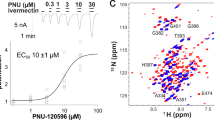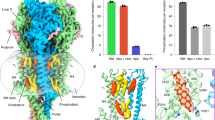Abstract
Canepa, Pauling and Sörum1 have reported the single crystal structure analysis of acetylcholine bromide and pointed out a correlation between that structure and those of choline chloride and muscarine iodide. In particular the (CH3)3N+–C–C–O– groups of all three are very similar in conformation with the ether oxygen atom gauche to the nitrogen atom. This correlation has been extended by Sundaralingam2, who has shown that in all molecules containing the N+–C–C–O– group the crystal structures of which are known (twelve) the oxygen atom is gauche to the nitrogen atom. Culvenor and Ham3 have concluded, however, on the basis of a nuclear magnetic resonance study of acetylcholine in D2O, that although it is gauche, the conformation of the acetylcholine molecule in solution is that of a normal primary ester4,5 in which the plane of the acetyl group is rotated about the O1–C5 bond (indicated by an arrow in Fig. 1) so as to bisect approximately the H–C5–H angle. This would give a C6–O1–C5–C4 torsion angle of approximately 180° instead of about ± 60° as observed in acetylcholine bromide. An important implication of this suggestion of Culvenor and Ham is that the spatial correlation between their proposed conformation of acetylcholine and the observed conformation of muscarine is much greater than the correlation between the conformation in acetylcholine bromide and muscarine6.
This is a preview of subscription content, access via your institution
Access options
Subscribe to this journal
Receive 51 print issues and online access
$199.00 per year
only $3.90 per issue
Buy this article
- Purchase on Springer Link
- Instant access to full article PDF
Prices may be subject to local taxes which are calculated during checkout
Similar content being viewed by others
References
Canepa, F. G., Pauling, P. J., and Sörum, H., Nature, 210, 907 (1966).
Sundaralingam, M., Nature, 217, 35 (1968).
Culvenor, C. C. J., and Ham, N. S., Chem. Commun., No. 15, 537 (1966).
Mathieson, A. McL., Tetrahedron Lett., No. 46, 4137 (1965).
Dunitz, J. D., and Strickler, P., in Structural Chemistry and Molecular Biology (edit. by Rich, A., and Davidson, N.), 595 (W. H. Freeman and Co., San Francisco, 1968).
Pauling, P. J., in Structural Chemistry and Molecular Biology (edit. by Rich, A., and Davidson, N.), 555 (W. H. Freeman and Co., San Francisco, 1968).
Liquori, A. M., Damiani, A., and de Coen, J. L., J. Mol. Biol, 33, 439 (1968).
Kier, L. B., Molecular Pharmacology, 3, 487 (1967).
Jellinek, F., Acta Cryst., 10, 277 (1957).
Author information
Authors and Affiliations
Rights and permissions
About this article
Cite this article
CHOTHIA, C., PAULING, P. Conformations of Acetylcholine. Nature 219, 1156–1157 (1968). https://doi.org/10.1038/2191156a0
Received:
Issue Date:
DOI: https://doi.org/10.1038/2191156a0
This article is cited by
-
Steroids and related studies, part 75: The crystal and molecular structure of 17a-(2-hydroxyethyl)-17a-aza-D-homo-5-androsten-3?ol (HS407)
Journal of Crystallographic and Spectroscopic Research (1989)
-
An EHT re-examination of Acetylcholine
Theoretica Chimica Acta (1973)
-
Structure and Activity of Muscarinic Stimulants
Nature (1971)
Comments
By submitting a comment you agree to abide by our Terms and Community Guidelines. If you find something abusive or that does not comply with our terms or guidelines please flag it as inappropriate.



